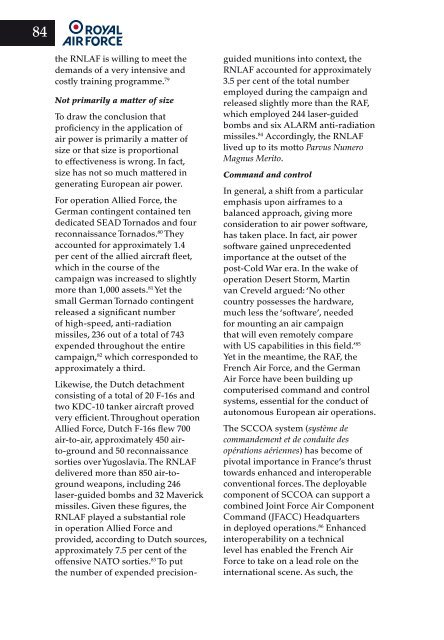You also want an ePaper? Increase the reach of your titles
YUMPU automatically turns print PDFs into web optimized ePapers that Google loves.
84<br />
the RNLAF is willing to meet the<br />
demands of a very intensive and<br />
costly training programme. 79<br />
Not primarily a matter of size<br />
To draw the conclusion that<br />
proficiency in the application of<br />
air power is primarily a matter of<br />
size or that size is proportional<br />
to effectiveness is wrong. In fact,<br />
size has not so much mattered in<br />
generating European air power.<br />
For operation Allied Force, the<br />
German contingent contained ten<br />
dedicated SEAD Tornados and four<br />
reconnaissance Tornados. 80 They<br />
accounted for approximately 1.4<br />
per cent of the allied aircraft fleet,<br />
which in the course of the<br />
campaign was increased to slightly<br />
more than 1,000 assets. 81 Yet the<br />
small German Tornado contingent<br />
released a significant number<br />
of high-speed, anti-radiation<br />
missiles, 236 out of a total of 743<br />
expended throughout the entire<br />
campaign, 82 which corresponded to<br />
approximately a third.<br />
Likewise, the Dutch detachment<br />
consisting of a total of 20 F-16s and<br />
two KDC-10 tanker aircraft proved<br />
very efficient. Throughout operation<br />
Allied Force, Dutch F-16s flew 700<br />
air-to-air, approximately 450 airto-ground<br />
and 50 reconnaissance<br />
sorties over Yugoslavia. The RNLAF<br />
delivered more than 850 air-toground<br />
weapons, including 246<br />
laser-guided bombs and 32 Maverick<br />
missiles. Given these figures, the<br />
RNLAF played a substantial role<br />
in operation Allied Force and<br />
provided, according to Dutch sources,<br />
approximately 7.5 per cent of the<br />
offensive NATO sorties. 83 To put<br />
the number of expended precision-<br />
guided munitions into context, the<br />
RNLAF accounted for approximately<br />
3.5 per cent of the total number<br />
employed during the campaign and<br />
released slightly more than the RAF,<br />
which employed 244 laser-guided<br />
bombs and six ALARM anti-radiation<br />
missiles. 84 Accordingly, the RNLAF<br />
lived up to its motto Parvus Numero<br />
Magnus Merito.<br />
Command and control<br />
In general, a shift from a particular<br />
emphasis upon airframes to a<br />
balanced approach, giving more<br />
consideration to air power software,<br />
has taken place. In fact, air power<br />
software gained unprecedented<br />
importance at the outset of the<br />
post-Cold War era. In the wake of<br />
operation Desert Storm, Martin<br />
van Creveld argued: ‘No other<br />
country possesses the hardware,<br />
much less the ‘software’, needed<br />
for mounting an air campaign<br />
that will even remotely compare<br />
with US capabilities in this field.’ 85<br />
Yet in the meantime, the RAF, the<br />
French <strong>Air</strong> Force, and the German<br />
<strong>Air</strong> Force have been building up<br />
computerised command and control<br />
systems, essential for the conduct of<br />
autonomous European air operations.<br />
The SCCOA system (système de<br />
commandement et de conduite des<br />
opérations aériennes) has become of<br />
pivotal importance in France’s thrust<br />
towards enhanced and interoperable<br />
conventional forces. The deployable<br />
component of SCCOA can support a<br />
combined Joint Force <strong>Air</strong> Component<br />
Command (JFACC) Headquarters<br />
in deployed operations. 86 Enhanced<br />
interoperability on a technical<br />
level has enabled the French <strong>Air</strong><br />
Force to take on a lead role on the<br />
international scene. As such, the

















